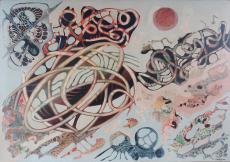


Ο Γιώργος Σκοτεινός έζησε έως τα 37 του χρόνια στην Αμμόχωστο, όταν αναγκάστηκε να την εγκαταλείψει το 1974 μαζί με ένα μεγάλο μέρος του έργου του, λόγω της κατάληψής της από τον τουρκικό στρατό. Από μικρός υπήρξε μάρτυρας των συνεχών ανακαλύψεων που η αρχαιολογική σκαπάνη έφερνε στο φως, κατά κύριο λόγο στις γειτονικές της Αμμοχώστου αρχαίες πόλεις της Έγκωμης και της Σαλαμίνας. Αυτός ο τεράστιος πολιτιστικός πλούτος που κρύβει στα σπλάχνα της η κυπριακή γη, ήδη από τη Λίθινη Εποχή, έθρεψε το έργο του από τα πρώτα βήματα της καλλιτεχνικής του πορείας.
Ο πρώτος κύκλος του εικαστικού έργου του που εκτείνεται από το 1965 έως το 1974 φέρει τον γενικό τίτλο Λιθοσέβεια. Η σειρά αυτή έχει θέμα της την ύλη ως φορέα πολιτισμού: με την ικανότητά της να μεταλλάσσεται και να επιβιώνει στον χρόνο, μεταφέρει ζωντανή στο παρόν μια ιστορία χιλιετιών. Το έργο Μεταβολισμός από την ομώνυμη ενότητα του κύκλου Λιθοσέβεια είναι εμπνευσμένο από αυτόν τον αέναο μεταβολισμό της ύλης. Σκοπεύει στη δημιουργία μιας οπτικής εμπειρίας του χρόνου, όπως αυτή αποτυπώνεται στην ύλη, που συνεχώς αλλοιώνεται και αναπαράγεται συνεχίζοντας τη ζωή με διαφορετικές κάθε φορά μορφές. Δημιουργήθηκε το 1968, έναν χρόνο μετά από το μνημειακό έργο του Τα Άλογα της Έγκωμης (ιδιωτική συλλογή Σ. Στεφάνου). Το τελευταίο φιλοτεχνήθηκε το 1967, ύστερα από την αρχαιολογική ανακάλυψη το 1966 ενός βασιλικού τάφου στην Έγκωμη, έναν σημαντικό οικισμό της Ύστερης Εποχής του Χαλκού. Στον τάφο βρέθηκαν, μαζί με τον επιφανή νεκρό, θαμμένα το άρμα και τα δύο άλογά του. Ο Σκοτεινός ζωγράφισε τους σκελετούς των δύο αλόγων όπως τους αντίκρισε μέσα στον τάφο, σε μια διαδικασία μεταβολισμού· δηλαδή όταν στο στάδιο της μετάβασης από τον θάνατο στη ζωή έπαιρναν τη μορφή των φυτών και των λουλουδιών της άγριας φύσης της περιοχής της Έγκωμης. Η εκδοχή ότι τα δύο άλογα θάφτηκαν ζωντανά μαζί με τον κύριό τους συγκίνησε ιδιαίτερα τον ζωγράφο, ο οποίος «είδε» στην πάλη τους να δραπετεύσουν, την προσπάθεια του ανθρώπου να ζήσει ελεύθερος. Μέρος του σκελετού των Αλόγων της Έγκωμης, όπως είναι γνωστά, ιχνηλατούμε και στο έργο Μεταβολισμός.
Χρησιμοποιώντας μια εξπρεσιονιστική σουρρεαλιστική γλώσσα, ο Σκοτεινός –εισηγητής του σουρρεαλισμού στην Κύπρο– δημιουργεί, με αφετηρία ρεαλιστικές εντυπώσεις, συμβολικούς χώρους, κόσμους ονείρου και ενόρασης, καταργώντας την έννοια του χρόνου και του χώρου. Στο έργο συμβιώνει η αφαίρεση με το μπαρόκ στοιχείο που προσδίδει στη σύνθεση δραματικότητα. Αυτή η δραματική αίσθηση που χαρακτηρίζει πολλά από τα έργα του θα μπορούσε να συνδεθεί με τα προσωπικά βιώματα του ζωγράφου, καθώς και αυτά της πατρίδας του. Τα έργα του εκπορεύονται πάντοτε από τις βιωματικές του εμπειρίες. Με ποιητική δύναμη και δημιουργική φαντασία προχωρεί στην κατασκευή συμβολικών κόσμων, δίνοντας μορφή στην ατομική αλλά και στη συλλογική συνείδηση.
Σπούδασε στην Αθήνα στη Δραματική Σχολή του Εθνικού Θεάτρου (1961-1964) και στη Νέα Υόρκη στις σχολές Visual Arts και Movie Subscription Group (1964-1967). Εμφανίστηκε στην κυπριακή εικαστική σκηνή το 1960. Η πρώτη μεγάλη σειρά έργων του φέρει τίτλο Λιθοσέβεια και περιλαμβάνει δημιουργίες σε υποενότητες φιλοτεχνημένες το διάστημα 1965-1974. Ύστερα από το 1974 ζωγράφισε τη μνημειακή σειρά έργων Ο Κύκλος της Καταγγελίας. Με αφετηρία τη βιωματική εμπειρία προχωρεί στη σύνθεση ποιητικών, συμβολικών κόσμων. Εκφράζεται με μια εξπρεσιονιστική, σουρρεαλιστική γλώσσα και στο έργο του συμβιώνει η αφαίρεση με το μπαρόκ στοιχείο. Παρουσίασε το έργο του σε 9 ατομικές εκθέσεις στην Κύπρο, στη Νέα Υόρκη (1966), στο Εδιμβούργο (1969), στο Τελ Αβίβ (1971), στην Αθήνα (1974), στη Βιέννη (1975), στη Βασιλεία (1975) και στο Αμβούργο (1991). Συμμετείχε σε πολλές ομαδικές εκθέσεις. Εκπροσώπησε την Κύπρο στην Μπιεννάλε Παρισίων (1967), στην Μπιεννάλε Αλεξάνδρειας (1968), στην Μπιεννάλε Βενετίας (1968), στην Μπιεννάλε Σάο Πάολο (1969), στην Τριεννάλε Ινδιών (1969, 1982). Το 1990 η Πινακοθήκη Tretyakov Μόσχας οργάνωσε αναδρομική έκθεση έργων του. Το 1982 τιμήθηκε με το χρυσό μετάλλιο στην Τριεννάλε Ινδιών.